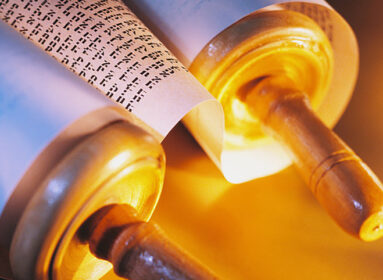By Shlomo Riskin ~
The Ark was the first of the sacred objects fashioned for the Sanctuary, which housed the holy tablets upon which were engraved the Ten Commandments. But why is the ark gold plated rather than made of pure gold – as are the ark-cover, the cherubs and the menorah? Gold plate is less valuable than pure gold – and the ark-cover is merely a protection for the Ark and is therefore less significant than the ark itself! So why is the sacred Ark made from gold plated acacia wood?
I would suggest that wood, which is derived from trees, symbolizes growth, development, fruits and future. Gold, by contrast is a precious metal deeply buried in the earth that neither ages nor tarnishes, neither decays nor destructs, expressing eternal value. Our Holy Torah must comprise both of these elements: eternity and creative advancement, timelessness as well as timeliness. The Holy Ark must be formed by vegetative tree-wood encased by gold that does not decay.
This dialectic combination of wood and gold is expressed in an equally striking manner by the two main leaders of the Israelites during the Biblical period, the prophet and the priest, Moses and Aaron. These two functionaries differed from each other in two ways. Firstly, the Kohen-priest derived his exalted office from his ancestors stretching all the way back to Aaron, elder brother of Moses. It was a matter of yihus, or ancestry. The prophet, on the other hand, could have been born into any family; his position was dictated exclusively by his personal charisma and spiritual passion. Secondly, the Kohen-priest wears special garb – four unique garments for the regular Kohen-priest and eight unique garments for the Kohen Gadol High Priest. Without these clothes, their divine service was disqualified. The Navi-prophet, by contrast, has no unique garb, his message and persona being the only significant aspect of his ministry.
These differences speak volumes about the specific function performed by each of these prototypical leaders. Religion in general and Judaism in particular provide two crucial and complementary components for which humanity yearns: a sense of participation in eternity, which is so important in our fast-changing world of flux, as well as a sense of purpose in a cosmos which too often seems to be governed by happenstance.
The Kohen-priest is minister of the Sanctuary and keeper of the Traditions.
He is responsible for the continuity, the structure, the permanence of our faith, expressed by time-honored ceremonials performed generation after generation. This is true of our prayer services, celebrations and life-cycle events. For this reason, the Kohen-priest receives the teachings from his parents and bequeaths them to his children, expressing the eternal chain of Jewish being which existed before each of us was born and will continue after each of us will die. This structure of continuity is symbolized by the unique external garb of the Kohen-priest, which was – and one day will again be transmitted from generation to generation.
But remembrance of past does not suffice unless it is relevant to the present. Continuity requires commitment, structure yearns for significance, permanence cries out for passion. We dare not repeat rituals merely because they were performed by our forebears. Our religious rite must not be allowed to degenerate into empty, habitual performance. The structured psalms must sensitize our souls, the detailed laws must infuse us with freely given love, and the emphasis on structure must allow for spiritual spontaneity. Fealty to the past cannot blind us to the challenges of the future. It was the charismatic prophet who extracted purpose and pathos from permanence and precedent. It was he who made G-d’s passion and fire infuse the laws and traditions with meaning for the moment. The Kohen-priest is the eternal gold of the Sacred Ark, and the prophet is the ever-growing tree-wood of the Sacred Ark.
And the tree grows and develops organically, reaching upwards and outwards, but still deeply rooted in the ancient and eternal earth. This challenging of integrating the old and the new confronts us as we face the challenges of the rights of women to learn, to lead and to be freed from enslaving relationships in the 21st century. Likewise, we must deal with the “other.” In our generation, these are the converts and the would-be-converts who come from different cultures and varied ethnic backgrounds, especially the new-immigrants to Israel from the former Soviet Union. These men and women are now Israeli citizens, but many of them are not yet halachically Jewish even though they are living and sacrificing in our midst. We dare not forget the very roots of our Jewish being, “And the Almighty created the human being in His image, in the image of G-d He created them, male and female created He them;” “You shall love the stranger for you were strangers in the land of Egypt!”
In the immortal words of Rav Kook, “May the old be renewed, and may the new be sanctified.”
Rabbi Shlomo Riskin is chancellor of Ohr Torah Stone and chief rabbi of Efrat, Israel.







 Southern New England Jewish Ledger
Southern New England Jewish Ledger














